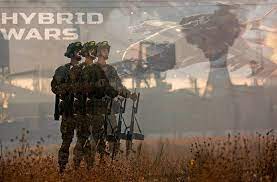Farzad Ahmad Cheema & Nazar Ahmad Niazi
Any form of warfare is destructive to the state. But, with the advancement in technology and developments in political ideologies, the forms and shapes of war have changed. The latest term of ‘hybrid warfare’ has been invented. Hybrid warfare is a complex and evolving concept that involves the use of non-military and military tactics, including information warfare, cyber-attacks, political subversion, and conventional warfare. It is a hidden form of warfare that affects the long-term existence of the state without letting people realize what’s happening.
“To fight and conquer in all battles is not supreme excellence; supreme excellence consists in breaking one’s resistance without fighting.”Sun Tzu Hybrid war is a type of warfare that uses many different tools, both conventional and unconventional. When these tools are used together in an organized way, the impact can be very bad, causing chaos and disorder in a short time. In traditional wars, non-military targets are not attacked, but in hybrid warfare, both military and non-military targets can be attacked at the same time, causing damage to the state, politics, and society. Hybrid warfare is not just about military actions but also includes political and diplomatic actions. One dangerous tool of hybrid warfare is information exploitation. This means that information can be used in a way that disrupts society and makes it hard to make good decisions. Social media plays a big role in this type of warfare, where false information and propaganda can be spread to achieve political goals.
As for Pakistan, the country has been facing various hybrid threats from its adversaries, particularly India. Hybrid warfare in Pakistan dates back to the period of 1970s and 1980s when Indians promoted Shaikh Mujib’s six points agenda. Secondly, the guerrilla resistance movement the Mukti Bahini was also supported by India especially by their secret agency RAW, even Indian Prime Minister Narendra Modi himself confess this in a statement. Hybrid Warfare emerged because of the global dislike of the use of Nuclear Weapons e.g.: when border tensions between Pakistan and India increased after the Pulwama attack, the whole world asked to solve this issue through dialogue because if a war started, there was a danger that the whole world suffers from it.
At present, Pakistan is facing nontraditional security threats mainly from India, Israel, and the United States, in the shape of poverty, education, global warming, climate change, and non-state actors such as Multinational cooperation’s, Non- governmental organizations. Nontraditional security threats are done through the controlling of narratives, cyber-attacks, secret use of irregular forces, and by providing diplomatic support to the rebels. The best example is Kalbhushan Yadav, he said that I am involved in providing diplomatic support to the rebels in the areas of Balochistan and Sindh. Second example: in a 2019 cricket world cup match a plane flies over on the ground with a banner, “Justice for Balochistan.” Third example: Narendra Modi said that he condemned the human rights violation in Balochistan, in his statement he threatens the sovereignty of Pakistan because this is an internal matter of Pakistan. Fourth example: In May 2019, a brutal attack took place at a luxurious hotel in the port city of Gwadar. The Prime minister of Pakistan, Imran Khan, strongly condemned the deadly incident. Stating that it was a deliberate attempt to undermine the country’s economic project and prosperity. He added that such actions, particularly in Balochistan, are aimed at sabotaging Pakistan’s economic growth, and the government will not allow these agendas to succeed. The Balochistan liberation army (BLA), a banned militant group, claimed responsibility for the attack. India is also imposing economic pain on Pakistan through the platform of FATF. India is trying its level best to include Pakistan in Black-list. Pakistan is facing a hybrid war in the shapes of political warfare, diplomacy warfare, and unconventional threats.
Instruments of hybrid warfare in Pakistan are mainly, Separatist movements, Insurgents in the Tribal Belt, Social Media Propagators of fake News, Target Killers in Karachi, etc. The separatist movements exploit the local people against the state and government. These movements are backed by foreign hands causing a disturbance in a region or the whole country. The insurgents in the Tribal areas of Pakistan use the techniques like suicidal bombing, conventional shootings, and bombings across various public areas of the country to create deterrence and violate the peace of the country. Social media propagators use the techniques like spreading fake news to provoke people against each other. Pakistan’s largest city Karachi almost from a decade facing target killings and attacks on common people. This was the clearest shape of hybrid warfare imposed by the enemy on Pakistan. Such killers destroyed the peace of the whole city. It’s being claimed by scholars that the Chinese (white colonists) physical appearance in Pakistan has complete resonance with Britishers (brown colonists) in the subcontinent. At present, the main targeted areas of Pakistan’s enemies are Gilgit-Baltistan, Balochistan, former FATA, and CPEC.
Most recent campaigns against Pakistan includes: India declared that Pakistan’s nuclear program is not in safe hands, they also declared Kashmir’s freedom fighters as terrorists, and America blamed Pakistan for its failure in Afghanistan, America, and India saying that CPEC is a debt trap, India is also funding the Bloch Liberation army, Pakistan Tahafuz movement, and Pakistan Tahrik Taliban and Finally the enemies propaganda against the Army and ISI through the use of Social Media. The enemies of Pakistan are blaming Pakistan for providing safe haven to terrorists to prove their claim wrong Pakistan take many initiatives, the most prominent of these are, Operation Zarb-e-Azab, Operation Radd-ul-Fasad and the National Action Plan after the alarming incident of APS.
Conclusion: Wars have always been fought with all the resources available to a nation such as money, politics, and diplomacy to achieve political objectives. A weaker nation always remains at the mercy of a stronger opponent. It does not mean that only having a top-class military equipped with the latest weapons of war is not enough to ensure survival. It means actually that the nation should be at peace with itself. The nation should have trust in its leadership and the capacity and capability of the state institutions to be responsible for its good. To achieve this country must be peaceful within itself. People should be given basic rights like food, shelter, education, and healthcare. The children should be in schools instead of on the streets begging. There should also be a quick and fair justice system. The government should be able to provide basic facilities like hospitals, water, and gas. The state should be caring towards its citizens and be in a position to be helpful to the needy. The police should safeguard the citizens from criminals and the army should be able to protect the borders.
Pakistan needs to develop a national policy plan to effectively handle the hybrid threats throughout the complete set of hybrid warfare doctrine, which includes cyber information warfare to physical kinetic operations, and political and diplomatic warfare. Pakistan should work with international organizations and economic groups which can help combat hybrid warfare at the international level. Media can play an important role in destroying the aggressor state’s agenda by giving correct information, Pakistan has been dominated by coercive diplomacy too. In Pakistan, there is a need to educate the people about coercive diplomacy and hybrid war. This only can be done by opening debates and addressing the youth through social media. Pakistan needs to analyze its foreign policy, and economic and domestic policies if they have to align with the current situation.







